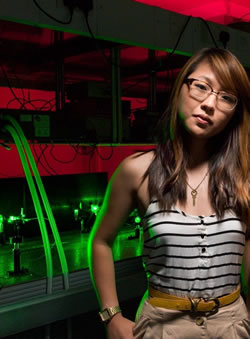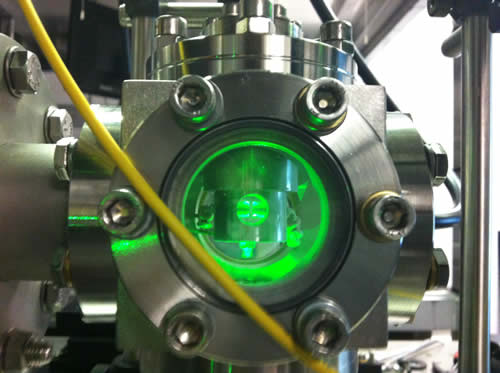#sheblindedmewithscience – meet Lia Ying Li
This is the second in a series of blogs by the five ScienceGrrls who featured in “She Blinded Me With Science”. If you haven’t yet seen the video, it’s here and all sales proceeds are being donated to ScienceGrrl!
 Hi! I’m Lia Ying Li and everyone knows me as ‘THE laser girl (who loves cats)’ which makes me sound like a superhero (awesome), but more importantly, shows how much physics has impacted my life. I built lasers from scratch in the final year of my undergraduate degree – my first taste of experimental research. I’ve been working with lasers ever since and I’m now near the end of my Ph.D at UCL, where the aim is to laser-cool large objects until they reach a quantum state.
Hi! I’m Lia Ying Li and everyone knows me as ‘THE laser girl (who loves cats)’ which makes me sound like a superhero (awesome), but more importantly, shows how much physics has impacted my life. I built lasers from scratch in the final year of my undergraduate degree – my first taste of experimental research. I’ve been working with lasers ever since and I’m now near the end of my Ph.D at UCL, where the aim is to laser-cool large objects until they reach a quantum state.
“She blinded me with science”
Filming the ‘She Blinded Me with Science’ video with Ceri Brenner at her workplace in RAL (the Rutherford Appleton Laboratory in Oxford) was a lot of fun because I’d never been to RAL before. It was inspiring to be in the same room as the VULCAN laser which is about 10,000,000,000,000 times more powerful than any laser I have in my own lab!
Here I am talking about lasers and quantum physics:
[fve]https://www.youtube.com/watch?v=j2BpzIIjvRo[/fve]
What is laser cooling?
When electrons, protons, neutrons, atoms and some molecules have been cooled to their quantum ground state they show amazing quantum behaviour such as being in two places at once, which is called “superposition of states”.
I work with tiny glass spheres around the diameter of a single strand of hair – that may sound small but it is enormous compared to atoms and molecules.
Everything is vibrating and moving ever so slightly due to heat and energy exchange, as well as the fact that we are always in contact with our environment. To cool something until it reaches its center of mass quantum ground state we want to remove this energy , and we do this by damping (reducing) the motion of an object. It works even better if your object is levitated and in a vacuum so nothing touches the sphere.
In our group, we cool by using the fact that light, to be precise, the photons in the light, have momentum and can push against objects (radiation pressure) and can therefore damp their motion.
The glass spheres I work with contain whispering gallery mode resonances, which is when light enters the sphere and gets confined inside due to total internal reflection. Light can only enter if you use a laser which you can accurately tune in wavelength (the colour) to match the resonance condition and excite the whispering gallery mode. This is a sensitive condition which becomes important for laser cooling!
The tiny movement of the sphere may not be noticeable to human eyes but affect things like lasers because of the Doppler shift which is the same effect heard in sound when an ambulance drives away or towards you. This Doppler shift changes whether the laser is in resonance with the glass sphere by shifting the laser wavelength by a tiny amount that is related to the velocity of the sphere. If you red-detune the laser (tune the wavelength to be ever so slightly larger than the resonance condition) the laser will only be in resonance when the motion of the sphere Doppler shifts it back, and this only happens if the sphere moves towards the laser. As it moves towards the laser, the radiation pressure builds up and pushes against the sphere, damping its motion.
Based on our calculations we could theoretically cool our sphere to a few milliKelvins! That’s just over 0.001 degrees above absolute zero which is -273.15 degrees Celsius.

An ion trap levitating a 10um diameter glass sphere, illuminated with a green laser. The sphere looks bigger than it actually is because of the light scattering off it
Getting people excited by quantum physics
I love that my Ph.D. now involves physics you don’t learn much about as a undergraduate; in fact, there are areas of quantum physics that NO-ONE understands. And this is super exciting!
It’s one of the main reasons James Millen and I set up The Quantum Workshop, funded by the Beacon Innovation Seed fund from UCL’s public engagement department. We travel the country with our laser that levitates dust particles to show at science festivals and we try and open up a discussion on what quantum physics is, why is it scary and what we are working on to understand it better. As the first female Ph.D. student in our research group I hope to encourage more girls to pursue physics, and hopefully show that there’s a place for them in this male-dominated industry, even within the highly competitive and challenging fields.
Lia Ying Li @kitty_mao
My blog: http://www.thekittylab.com & LinkedIn: http://www.linkedin.com/in/liayingli
